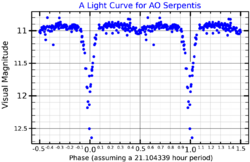Astronomy:AO Serpentis
| Observation data Equinox J2000.0]] (ICRS) | |
|---|---|
| Constellation | Serpens |
| Right ascension | 15h 58m 18.410s[2] |
| Declination | +17° 16′ 10.00″[2] |
| Apparent magnitude (V) | 11.04±0.09[3] |
| Characteristics | |
| Spectral type | A2[4] |
| B−V color index | 0.22[3] |
| Variable type | β Per + δ Sct[5] |
| Astrometry | |
| Primary | |
| Proper motion (μ) | RA: −8.236[2] mas/yr Dec.: −10.444[2] mas/yr |
| Parallax (π) | 2.2539 ± 0.0229[2] mas |
| Distance | 1,450 ± 10 ly (444 ± 5 pc) |
| Absolute magnitude (MV) | +1.88±0.03 |
| Secondary | |
| Absolute magnitude (MV) | +5.17±0.05 |
| Orbit[5] | |
| Period (P) | 0.8793496±0.0000047 d |
| Semi-major axis (a) | 5.59±0.05 R☉ |
| Inclination (i) | 90.0±1.5° |
| Longitude of the node (Ω) | 3.645±0.002° |
| Periastron epoch (T) | 2,457,127.5076±0.0041 HJD |
| Semi-amplitude (K1) (primary) | 51.6±1.1 km/s |
| Semi-amplitude (K2) (secondary) | 270.3±3.6 km/s |
| Details[5] | |
| Primary | |
| Mass | 2.55±0.09 M☉ |
| Radius | 1.64±0.02 R☉ |
| Luminosity | 14.45+0.69 −0.65 L☉ |
| Surface gravity (log g) | 4.42±0.01 cgs |
| Temperature | 8,820±62 K |
| Rotational velocity (v sin i) | 90±18 km/s |
| Secondary | |
| Mass | 0.49±0.02 M☉ |
| Radius | 1.38±0.02 R☉ |
| Luminosity | 0.93+0.05 −0.04 L☉ |
| Surface gravity (log g) | 3.85±0.01 cgs |
| Temperature | 4,786±11[4] K |
| Other designations | |
| Database references | |
| SIMBAD | data |
AO Serpentis is an eclipsing binary star system in the Serpens Caput segment of the Serpens constellation. It is invisible to the naked eye with a typical apparent visual magnitude of 11.04.[3] Variable star observers record a peak magnitude of 10.7, dropping to 12.0 during the primary eclipse and 10.8 from the secondary eclipse.[7] The distance to this system is approximately 1,450 light years based on parallax measurements.[2]
This system was discovered by C. Hoffmeister to be an Algol-type eclipsing binary in 1935.[8] The following year, P. Guthnick and R. Prager reported a brightness variation between 10.5 and 12.0.[9] In 2004, S. -L. Kim and associates determined that one of the components of this system is pulsating with a short period.[10]
This is a semi-detached binary star system with the secondary component completely filling its Roche lobe while the primary is 61% full. It has an orbital period of 21.1 hours and a semimajor axis of just 5.6 times the radius of the Sun. The orbital plane is inclined by an angle of 90° to the line of sight, causing the secondary component to be completely eclipsed once per orbit.[5] The orbital period shows long-term cyclic variations, changing by up to 0.0051 days every 17.32 years. This may be due to magnetic activity cycles or the influence of a third body. The orbital period as a whole is steadily decreasing at the rate of (−5.39±0.03)×10−7 days yr−1 due to loss of mass and angular momentum by the system.[4]
The physical properties of the stellar components can be explained by a mass transfer. At some point in the past, mass flowed from the (at the time) more massive and evolved secondary component. This has left the primary as an A-type main-sequence star while the secondary is less massive but overly large. The hotter primary component is a Delta Scuti variable that is undergoing radial pulsation with a dominant frequency of 21.852 days−1 and a secondary frequency of 23.484 days−1.[5]
References
- ↑ "ASAS-SN Variable Stars Database". ASAS-SN. https://asas-sn.osu.edu/variables/lookup.
- ↑ Jump up to: 2.0 2.1 2.2 2.3 2.4 Brown, A. G. A. (2021). "Gaia Early Data Release 3: Summary of the contents and survey properties". Astronomy & Astrophysics 649: A1. doi:10.1051/0004-6361/202039657. Bibcode: 2021A&A...649A...1G. Gaia EDR3 record for this source at VizieR.
- ↑ Jump up to: 3.0 3.1 3.2 Høg, E. et al. (2000), "The Tycho-2 catalogue of the 2.5 million brightest stars", Astronomy and Astrophysics 355: L27, doi:10.1888/0333750888/2862, ISBN 978-0333750889, Bibcode: 2000A&A...355L..27H.
- ↑ Jump up to: 4.0 4.1 4.2 Yang, Y. -G. et al. (April 2010), "Photometric Properties for Selected Algol-type Binaries. II. AO Serpentis and V338 Herculis", The Astronomical Journal 139 (4): 1360–1368, doi:10.1088/0004-6256/139/4/1360, Bibcode: 2010AJ....139.1360Y.
- ↑ Jump up to: 5.0 5.1 5.2 5.3 5.4 Park, Jang-Ho et al. (December 2020), "Physical Nature of the Eclipsing δ Scuti Star AO Serpentis", The Astronomical Journal 160 (6): 9, doi:10.3847/1538-3881/abbef4, 247, Bibcode: 2020AJ....160..247P.
- ↑ "AO Ser". SIMBAD. Centre de données astronomiques de Strasbourg. http://simbad.u-strasbg.fr/simbad/sim-basic?Ident=AO+Ser.
- ↑ Samus', N. N et al. (2017), "General catalogue of variable stars", Astronomy Reports, GCVS 5.1 61 (1): 80, doi:10.1134/S1063772917010085, Bibcode: 2017ARep...61...80S.
- ↑ Hoffmeister, Cuno (June 1935), "162 neue Veräderliche", Astronomische Nachrichten 255 (22): 401, doi:10.1002/asna.19352552202, Bibcode: 1935AN....255..401H.
- ↑ Guthnick, P.; Prager, R. (October 1936), "Benennung von veränderlichen Sternen", Astronomische Nachrichten 260 (22): 393, doi:10.1002/asna.19362602202, Bibcode: 1936AN....260..393G.
- ↑ Kim, S. -L. et al. (June 2004), "Discovery of a short-periodic pulsating component in the Algol-type eclipsing binary system AO Ser", Information Bulletin on Variable Stars 5538: 1, Bibcode: 2004IBVS.5538....1K.
 |


